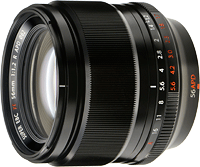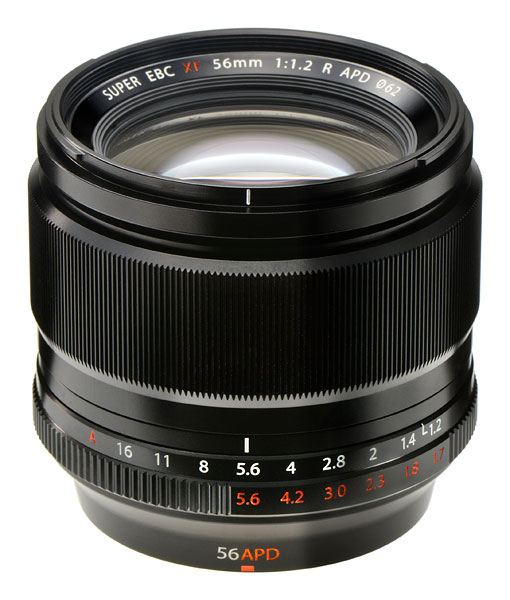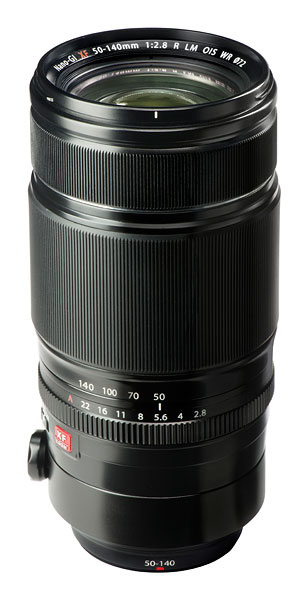Fuji XF56mm portrait prime promises super-creamy bokeh; weather-sealed XF50-140mm also imminent
posted Wednesday, September 10, 2014 at 12:01 AM EST

Alongside the launch of the new Fuji X-T1 Graphite Silver kit, the company has also announced imminent availability of two new lenses that will have X-mount shooters doubly excited. Of the two optics, one has been on the roadmap for a while, and the other is a new addition that tweaks an existing model for even more deliciously creamy bokeh.
It's the latter we find to be particularly interesting. The brand-new FUJINON XF56mmF1.2 R APD lens is a variant of the existing FUJINON XF56mmF1.2 R, which we were wowed by on sister site SLRgear.com last March, calling it a "another triumph" and Fujifilm's "premiere portrait lens". It may have to cede the latter title to the new version, which is aimed specifically at providing even more attractive bokeh -- and the original already had creamy bokeh, mind you!
So how did Fujifilm improve bokeh characteristics of this new lens? The answer can be summed up in one (perhaps unfamiliar) word: Apodization. If you know what that means, you can skip to the next paragraph; if not, let's continue. Essentially, what an apodization lens does -- and this isn't the first, an earlier example would be Minolta's STF 135mm f/2.8 T4.5 -- is to place an additional filter into the optical path that alters the intensity profile of the incoming light.

The filter is dark at the outside, with circular gradation that lightens it until, some distance from the center of the image, it becomes completely transparent. In essence, it acts as a softly-feathered aperture when the lens' physical aperture diaphragm is wide open, and the effect is to further smooth bokeh, yielding a more attractive, less visually distracting background. As you stop down, though, the physical aperture becomes gradually more prominent, until the apodization filter has no effect at all and the lens acts just as if it were a standard one.
For portraits in particular, the ability to soften backgrounds is great news, but if it's that simple why don't all lenses include these filters? Well, the answer like so many things in life is that it's a tradeoff. If you place this filter in the optical path, you are essentially rejecting some incoming light, and while that doesn't change the lens' F-stop, it does change its T-stop, or light transmission efficiency. The effect on the T-stop is much like that on bokeh: significant when wide-open, but gradually reducing as you stop down. Orange numbers surrounding the lens barrel beneath the white aperture markings chart that progression, from a T-stop of 1.7 at f/1.2, down to a match between the T-stop and F-stop from f/5.6. Beyond that point, there's no negative impact on light transmission.
Long story short, if you want the maximum light transmission near wide-open, the standard version of the lens will prove to be preferable. If you want creamier backgrounds and are willing to live with the tradeoff in T-stop values, though, then the Fuji 56 APD version is the one to go for. Pricing for this new version is set at US$1,500, with availability from December 2014. That's about US$500 (or 50%) more than list pricing of the regular optic, so price will also likely play a big part in your purchase decision.

The other new lens is one we knew from Fuji's lens roadmap to be on the way by year's end, but now we have basic specifications and a launch date. The bright, constant-aperture FUJINON XF50-140mmF2.8 zoom is equivalent to a 76-213mm optic when mounted on an X-mount body, and it has a weather-resistant design with no less than 20 different seals throughout its construction. It has a complex 23-element, 16-group optical formula with five ED and one Super ED elements, and uses a new Nano-GI coating that alters the refractive index between glass and air, thereby reducing both ghosting and flare effects.
It also features optical image stabilization and a seven-bladed, rounded aperture diaphragm. Fujifilm further notes that a world's first Triple Linear Motor system equally spacing three AF drive motors around the focusing group allows quiet and fast autofocus, and notes that the lens barrel doesn't change in length during zoom operation, something that will prove particularly useful when shooting movies, since change to the camera's balance will be minimized (and therefore, your tendency to raise or lower the lens unintentionally.)
Also available from December 2014, the Fuji 50-140 lens carries a list price of US$1,600 or thereabouts.
Place your pre-order with a trusted Imaging Resource affiliate now:
-
Fuji XF 56mm f/1.2 R APD Lens, US$1,499: ADORAMA | AMAZON | B&H
-
Fuji XF 50-140mm f/2.8 R LM OIS WR Lens, US$1,599: ADORAMA | AMAZON | B&H